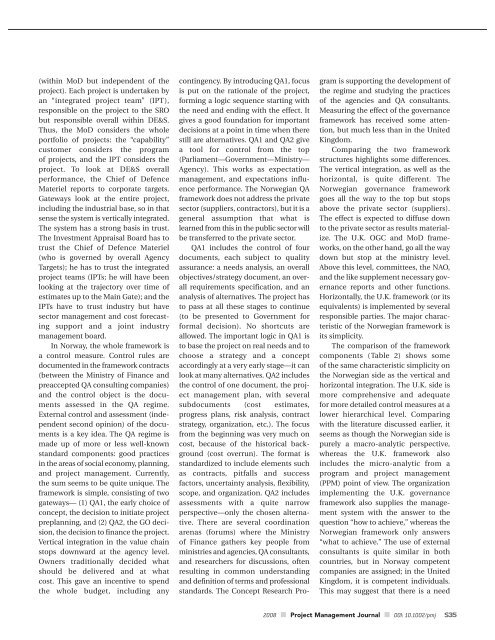Link to thesis. - Concept - NTNU
Link to thesis. - Concept - NTNU
Link to thesis. - Concept - NTNU
- No tags were found...
Create successful ePaper yourself
Turn your PDF publications into a flip-book with our unique Google optimized e-Paper software.
(within MoD but independent of theproject). Each project is undertaken byan “integrated project team” (IPT),responsible on the project <strong>to</strong> the SRObut responsible overall within DE&S.Thus, the MoD considers the wholeportfolio of projects: the “capability”cus<strong>to</strong>mer considers the programof projects, and the IPT considers theproject. To look at DE&S overallperformance, the Chief of DefenceMateriel reports <strong>to</strong> corporate targets.Gateways look at the entire project,including the industrial base, so in thatsense the system is vertically integrated.The system has a strong basis in trust.The Investment Appraisal Board has <strong>to</strong>trust the Chief of Defence Materiel(who is governed by overall AgencyTargets); he has <strong>to</strong> trust the integratedproject teams (IPTs; he will have beenlooking at the trajec<strong>to</strong>ry over time ofestimates up <strong>to</strong> the Main Gate); and theIPTs have <strong>to</strong> trust industry but havesec<strong>to</strong>r management and cost forecastingsupport and a joint industrymanagement board.In Norway, the whole framework isa control measure. Control rules aredocumented in the framework contracts(between the Ministry of Finance andpreaccepted QA consulting companies)and the control object is the documentsassessed in the QA regime.External control and assessment (independentsecond opinion) of the documentsis a key idea. The QA regime ismade up of more or less well-knownstandard components: good practicesin the areas of social economy, planning,and project management. Currently,the sum seems <strong>to</strong> be quite unique. Theframework is simple, consisting of twogateways— (1) QA1, the early choice ofconcept, the decision <strong>to</strong> initiate projectpreplanning, and (2) QA2, the GO decision,the decision <strong>to</strong> finance the project.Vertical integration in the value chains<strong>to</strong>ps downward at the agency level.Owners traditionally decided whatshould be delivered and at whatcost. This gave an incentive <strong>to</strong> spendthe whole budget, including anycontingency. By introducing QA1, focusis put on the rationale of the project,forming a logic sequence starting withthe need and ending with the effect. Itgives a good foundation for importantdecisions at a point in time when therestill are alternatives. QA1 and QA2 givea <strong>to</strong>ol for control from the <strong>to</strong>p(Parliament—Government—Ministry—Agency). This works as expectationmanagement, and expectations influenceperformance. The Norwegian QAframework does not address the privatesec<strong>to</strong>r (suppliers, contrac<strong>to</strong>rs), but it is ageneral assumption that what islearned from this in the public sec<strong>to</strong>r willbe transferred <strong>to</strong> the private sec<strong>to</strong>r.QA1 includes the control of fourdocuments, each subject <strong>to</strong> qualityassurance: a needs analysis, an overallobjectives/strategy document, an overallrequirements specification, and ananalysis of alternatives. The project has<strong>to</strong> pass at all these stages <strong>to</strong> continue(<strong>to</strong> be presented <strong>to</strong> Government forformal decision). No shortcuts areallowed. The important logic in QA1 is<strong>to</strong> base the project on real needs and <strong>to</strong>choose a strategy and a conceptaccordingly at a very early stage—it canlook at many alternatives. QA2 includesthe control of one document, the projectmanagement plan, with severalsubdocuments (cost estimates,progress plans, risk analysis, contractstrategy, organization, etc.). The focusfrom the beginning was very much oncost, because of the his<strong>to</strong>rical background(cost overrun). The format isstandardized <strong>to</strong> include elements suchas contracts, pitfalls and successfac<strong>to</strong>rs, uncertainty analysis, flexibility,scope, and organization. QA2 includesassessments with a quite narrowperspective—only the chosen alternative.There are several coordinationarenas (forums) where the Ministryof Finance gathers key people fromministries and agencies, QA consultants,and researchers for discussions, oftenresulting in common understandingand definition of terms and professionalstandards. The <strong>Concept</strong> Research Programis supporting the development ofthe regime and studying the practicesof the agencies and QA consultants.Measuring the effect of the governanceframework has received some attention,but much less than in the UnitedKingdom.Comparing the two frameworkstructures highlights some differences.The vertical integration, as well as thehorizontal, is quite different. TheNorwegian governance frameworkgoes all the way <strong>to</strong> the <strong>to</strong>p but s<strong>to</strong>psabove the private sec<strong>to</strong>r (suppliers).The effect is expected <strong>to</strong> diffuse down<strong>to</strong> the private sec<strong>to</strong>r as results materialize.The U.K. OGC and MoD frameworks,on the other hand, go all the waydown but s<strong>to</strong>p at the ministry level.Above this level, committees, the NAO,and the like supplement necessary governancereports and other functions.Horizontally, the U.K. framework (or itsequivalents) is implemented by severalresponsible parties. The major characteristicof the Norwegian framework isits simplicity.The comparison of the frameworkcomponents (Table 2) shows someof the same characteristic simplicity onthe Norwegian side as the vertical andhorizontal integration. The U.K. side ismore comprehensive and adequatefor more detailed control measures at alower hierarchical level. Comparingwith the literature discussed earlier, itseems as though the Norwegian side ispurely a macro-analytic perspective,whereas the U.K. framework alsoincludes the micro-analytic from aprogram and project management(PPM) point of view. The organizationimplementing the U.K. governanceframework also supplies the managementsystem with the answer <strong>to</strong> thequestion “how <strong>to</strong> achieve,” whereas theNorwegian framework only answers“what <strong>to</strong> achieve.” The use of externalconsultants is quite similar in bothcountries, but in Norway competentcompanies are assigned; in the UnitedKingdom, it is competent individuals.This may suggest that there is a need2008 ■ Project Management Journal ■ DOI: 10.1002/pmj S35
















